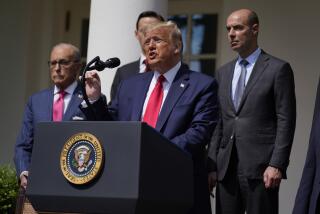Unions as One of the Points of Light : Labor: By organizing, living standards of low-wage workers could be improved, limiting pressure for new government programs. But labor law must first be reformed.
- Share via
Income polarization is a legacy of the 1980s. From 1979 to 1987, the living standards of the richest fifth of American families rose by 19%. Those of the poorest fifth fell by 9%.
During this business cycle, professional-technical occupations grew. But even more low-wage jobs in services and in labor-intensive manufacturing were created. By 1988, real wages, on average, were lower than at any time since 1960. Poverty, once associated with unemployment, now comes with full-time work.
Washington and Sacramento acknowledge crises of the working poor--no health insurance, a shortage of low-income housing, child care’s prohibitive cost. But, our leaders insist, tight budgets preclude new public programs. Instead, President Bush, using imagery of a “thousand points of light,” pushes for private solutions.
One private-sector solution, though shunned by conservatives, is unionization. It would improve living standards of low-wage workers, limiting pressure for new government programs.
Today, barely 10% of private-sector workers are represented by unions. Labor’s decline has aggravated urban poverty. Of the 37 million Americans without health insurance, two-thirds are employees or their dependents. Most work for non-union firms.
Los Angeles’ work force now includes more than 300,000 in such low-wage industries as furniture, apparel, hotels and restaurants; 90% of them are non-union. Many earn minimum wage or less and receive no health benefits. A single apartment is frequently home for several of their families.
What few union contracts there are in these industries usually specify an hourly rate of $6 to $7. Health insurance is almost always part of the agreements.
The collective bargaining that produces these contracts preserves private-sector flexibility. The firms’ ability to pay sets the upper limits on what unions can win. Sometimes, unions miscalculate, demanding contracts so rich that a firm can’t survive. But recent history shows that when troubled companies have demanded wage and benefit reductions, unions often have gone along. Still, even the resulting lower wage scales remain higher than pay at comparable non-union firms.
In the 1970s, 200,000 workers a year, on average, were organized. In the 1980s, organizing rates were halved while low-wage employment grew. Possible reasons included labor’s lack of resources devoted to recruiting, union corruption and publicity about “givebacks.” But various legal obstacles to organizing and the impotence of labor law in the face of new employer tactics are the primary causes of the decline. Indeed, while Americans applaud Solidarity in Poland, U.S. labor law practically forecloses the right to unionize.
Last year, 3,000 Nissan workers in Tennessee voted against United Auto Workers representation. During the months leading up to the vote, Nissan broadcast anti-union messages on TV monitors located throughout its factory. To respond to this TV barrage, UAW organizers, barred from the plant, had to search out employee home addresses, visiting the workers in the evenings and on weekends. The law does not require that unions be given a voter list until several weeks before the vote, even though a campaign can run a year or longer.
Americans would normally consider such election procedures--one party having exclusive access to TV and to voter lists, requiring voters to listen to one-sided campaign rhetoric during paid working time--unfair. Yet, this is how the National Labor Relations Board conducts representation elections to test if workers freely choose a union.
The board and various court decisions have progressively diluted worker rights to free elections. For example, before 1980, if a company fired a union activist for tardiness, it had to produce records showing that late non-union workers had been similarly discharged. Under current rules, it is the union, though lacking access to personnel records, that must research and prove that a company discriminated against a union worker. Also, firings were previously unlawful if partly motivated by workers’ union affiliation. Now, the labor relations board permits firms to cite union activism as a cause for dismissal, provided employers can demonstrate the legitimacy of other reasons. In short, the law protects only perfect employees.
In 1977, the House of Representatives voted for labor law reform that would have eliminated the most egregious impediments to union organizing. But Senate supporters fell two votes short of the 60 needed to end an anti-union filibuster. The bill died.
That legislation would have required union elections to be scheduled more promptly, increased the penalties for retaliating against union activists, provided unions with greater access to voters (including equal time when companies propagandize employees at the workplace) and allowed compensation to workers denied wage improvements because their companies unlawfully refused to bargain.
Today, unionization of low-wage workers is not only a matter of their welfare. All taxpayers have an interest in encouraging collective bargaining to reduce the working poor’s burden on public services. Toward that end, labor law reform should be made a priority by conservatives and liberals alike. The right of low-wage workers to improve their lot, without government subsidy, is surely one of those thousand points of light.
More to Read
Inside the business of entertainment
The Wide Shot brings you news, analysis and insights on everything from streaming wars to production — and what it all means for the future.
You may occasionally receive promotional content from the Los Angeles Times.










